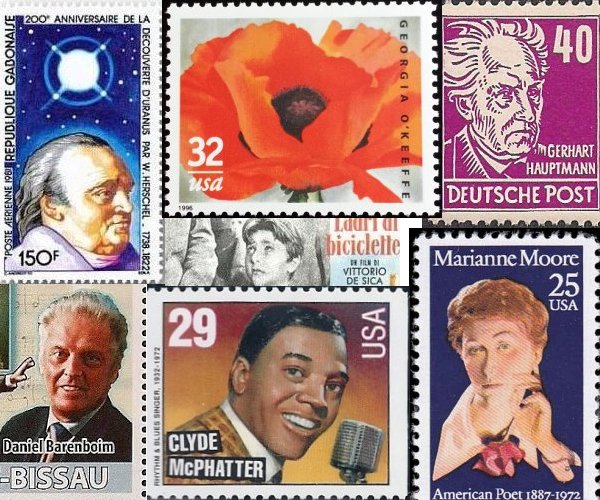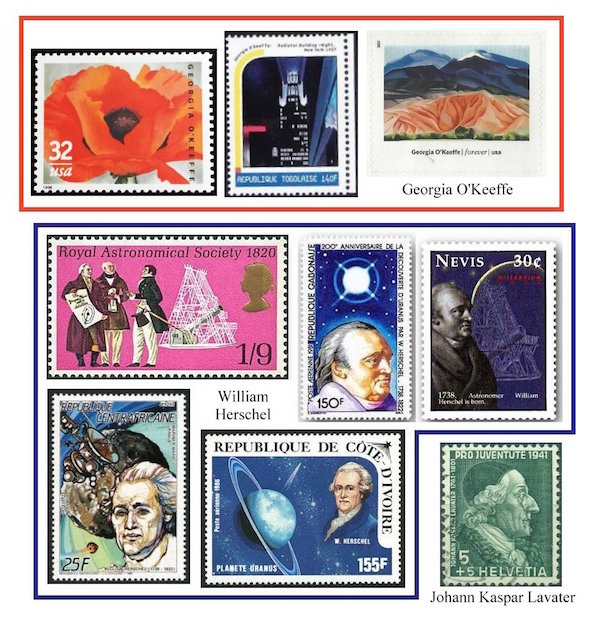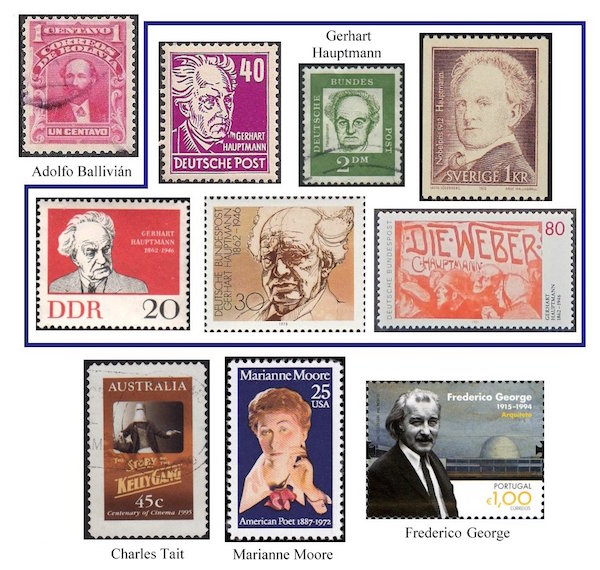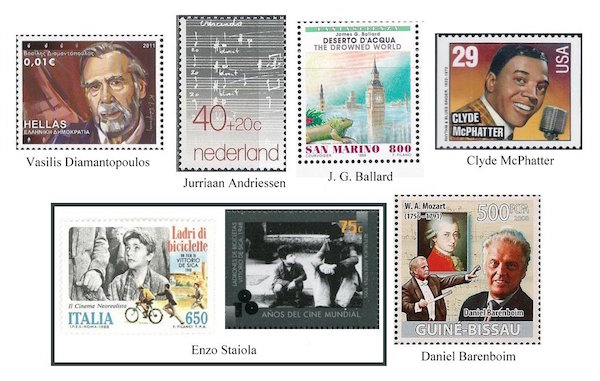The Arts on Stamps of the World — November 15
An Arts Fuse regular feature: the arts on stamps of the world.

By Doug Briscoe
Today we doff our birthday hats to Georgia O’Keeffe, Gerhart Hauptmann, Marianne Moore, and Daniel Barenboim. And I’ll bet you didn’t know that astronomer Sir William Herschel, who discovered the planet Uranus, was also a composer several of whose works have been recorded.
Queen for a Day, if the day is November 15, is Georgia O’Keeffe (November 15, 1887 – March 6, 1986). She was born in Wisconsin to parents who were dairy farmers, but contrary to one’s expectations, perhaps, her mother’s father was an Hungarian count (!) who had come to America in the Revolution year of 1848. O’Keeffe decided from an early age on a career as an artist. She attended the Art Institute of Chicago and studied in New York under William Merritt Chase (whose birthday was exactly two weeks ago). Some of her drawings found their way to Alfred Stieglitz, who showed ten of them in his New York gallery, 291, in 1916. O’Keeffe moved to the city from Texas in 1918, and soon she and Stieglitz were lovers, despite his marriage. Her concentration on painting flowers began around this time. She and Stieglitz married in 1924, and O’Keeffe had a retrospective of her work at the Brooklyn Museum as early as 1927. (Her MOMA retrospective twenty years later —1946, the year of Stieglitz’s death—was the first by a woman at that institution.) She first traveled to Taos in 1929, revisiting New Mexico almost every year thereafter. O’Keeffe was dogged by ill health at various points in her life: typhoid fever in 1906-07, measles in 1910, Spanish flu in 1918, and poor health forced her to give up painting for a few years in the early 1930s. She began to suffer from macular degeneration, losing much of her vision by 1972, but she went on creating, first watercolors, then drawings in pencil and charcoal until 1984. The first Georgia O’Keeffe stamp (1992) displayed her Red Poppy of 1927. The stamp from Togo shows a painting from the same year: Radiator Building—Night, New York. This may seem decidedly uncharacteristic, but O’Keeffe completed a number of cityscapes while in New York in the twenties. Finally, as one of the American artists represented on a 2013 sheet, O’Keeffe was saluted with her Black Mesa Landscape, New Mexico / Out Back of Marie’s II, 1930.

The stamps for German-born British astronomer Sir William Herschel (15 November 1738 – 25 August 1822) honor him for his important work as a scientist—as I said above, he was the discoverer of the planet Uranus in 1781—but he also wrote a fair amount of music. Two dozen symphonies, fourteen concertos, chamber and keyboard pieces, a Te Deum and other vocal works make up his canon. Recordings of some of his orchestral music can be found on the Chandos and Newport labels. Born Friedrich Wilhelm Herschel in the Electorate of Hanover, he came to Britain in 1757. The British stamp at upper left shows him as first President of the Royal Astronomical Society, holding his drawing of Uranus; with him are Francis Baily and Herschel’s son John.
Three years younger than Sir William was the Swiss theologian Johann Kaspar Lavater (15 November 1741 – 2 January 1801), a poet and philosopher who also had some now largely discounted theories about physiognomy. Born in Zürich, he entered Holy Orders there and wrote on religious matters as well as producing verse that included two epic poems on Jesus the Messiah (1780) and Joseph of Arimathea (1794). He was friendly for a time with Goethe, but the great poet later broke with Lavater, accusing him of superstition and hypocrisy. During the French occupation of Zürich in 1799, Lavater was shot by an irate soldier and lingered on for more than a year before dying of complications from his wound.
Adolfo Ballivián (1831–1874) was president of Bolivia in the last nine months of his life. (He died of stomach cancer while in office.) His father, General José Ballivián, had been president before him (1841-47). Adolfo, an enlightened and cultivated democrat, composed piano pieces—marches, polkas, galops, opera fantasies, etc.—up to Opus 53.
Nobel Prize winning German playwright Gerhart Hauptmann (15 November 1862 – 6 June 1946) also wrote novels and verse for which he was much admired during his lifetime, if there has been a falling off in his popularity since his death. He came from Lower Silesia (then in Prussia, now Poland) and set out to be a sculptor. His attempts met with little success—one of his efforts even collapsed—and he turned to writing, his first play being produced in 1889. This play, Before Sunrise, is held to have introduced naturalism into German literature. Three years later he wrote what is likely his best known play, at least outside Germany, The Weavers (1892), about a workers’ uprising set in 1844. This play is even prominently named and illustrated on one of the Hauptmann postage stamps. By the end of the century Hauptmann was internationally recognized. He came out with his first novel in 1910 and was the recipient of the Nobel Prize in Literature in 1912. In contradistinction to his declared pacifism and criticism of the military, he supported Germany’s actions in World War I. After the war he made another seeming volte-face by writing a memorial to a pacifist who had been murdered by ultra-nationalists, then declared his support for the republic. His relationship with the Nazis was problematic. On the one hand, he had been a longtime believer in the benefits of eugenics and signed a loyalty oath for the new regime’s German Academy of Literature, but on the other hand he was always viewed with suspicion by Goebbels, et al., who canceled the production of one his plays because it wasn’t patriotic enough, banned a novella because it included a positively portrayed black character, prohibited a film of his old play Schluck und Jau, and censored other works. He received honors on his 70th birthday with the grudging participation of party members. After the Second War his home lay in the territory that was to be ceded to Poland, but he died before being forced to leave. Besides his many plays, there are seven novels, seven novellas, and five verse novels. Oh, yes, and half a dozen stamps.

Australian entrepreneur Charles Tait (15 November 1868 – 27 June 1933) is most remembered for the film The Story of the Kelly Gang, which he wrote and directed. It’s considered to be the world’s very first feature-length film—it runs just over an hour—and was first shown on 26 December 1906. For a 1995 stamp issue commemorating a century of Australian cinema, this film about the outlaw Ned Kelly was one of the pictures cited.
American poet Marianne Moore (November 15, 1887 – February 5, 1972), a lifelong Presbyterian whose faith was central to her life, was born in Missouri and lived there until she was sixteen, then moved with her family to Pittsburgh and later attended Bryn Mawr, where one of her fellow students was the poet H.D (Hilda Doolittle). Moore wrote some pieces for the campus magazine but didn’t publish professionally until 1915. The next year she and her mother moved to Greenwich Village, where Moore’s work was celebrated by all the top poets of the day, William Carlos Williams, T. S. Eliot, Wallace Stevens, and her friend H.D., who in 1921 published Moore’s first book of poetry without the author’s permission. She translated La Fontaine, was a big baseball fan, won the Pulitzer for her Collected Poems in 1951, and was invited to come up with a name for a new Ford vehicle in 1955. They rejected all her (tongue-in-cheek) suggestions and called it the Edsel. Some of the names she came up with (such as “Varsity Stroke” and “Pastelogram”) with not come as a surprise to those familiar with the wit of her poetry.
Now we turn to Portuguese architect and painter Frederico George (15 November 1915 – 26 January 1994). He was born in Lisbon and attended the School of Fine Arts there, beginning with a course of study in painting, but receiving his degree in architecture. Examples of his painting I found online are this Nude (c1940) and a Self-Portrait (1939). Most of George’s architectural projects were done for his native city, such as the Calouste Gulbenkian Planetarium.
Greek actor Vasilis Diamantopoulos (November 15, 1920 – May 5, 1999) was, according to Wikipedia, the first actor to appear live on Greek television in 1966. He was born at Piraeus and studied both law and drama. One of the founders of the Modern Theater, he played in many films and television productions in addition to his long career on the stage.
Jurriaan Andriessen (15 November 1925 – 19 August 1996) came from a family of Dutch composers that included his father Hendrik, brother Louis, and uncle Willem. Andriessen studied composition with his father and with Olivier Messiaen. He composed in most genres: there are stage works, at least eight symphonies, numerous concerted works, and a large body of music for wind orchestra. One of his choral works, Psalm Trilogy for baritone, mixed chorus, and orchestra (1977), is represented on this Netherlands stamp of 1979. He was in the United States from 1949 to 1951 and while here wrote his First Symphony, called “Berkshire Symphonies”, and a Tanglewood Overture for Serge Koussevitsky.
English novelist J(ames) G(raham) Ballard (15 November 1930 – 19 April 2009) was primarily a science fiction writer, but in his later years he turned to crime fiction. If you’re a fan of neither genre, you may know him as the author of the semi-autobiographical novel Empire of the Sun (1984), which served as a vehicle for the Steven Spielberg film of the same name (1987). It tells the story of a young British boy separated from his parents when the Japanese invade Shanghai (where Ballard was indeed born). Ballard was interned at a camp for two years (though, in historical fact, he was never apart from his family) and was about fifteen when his parents returned with him to England. He studied medicine and took up writing but did not turn to science fiction until his time serving in the RAF in Canada in the mid-fifties. His second novel, The Drowned World, established him as a new voice in the genre.

Clyde McPhatter (November 15, 1932 – June 13, 1972) had a disappointing career and a short life. Born in Durham, North Carolina to a Baptist preacher, he sang as a small child in the church’s gospel choir (as did his three brothers and three sisters). He was performing solos by the time he was ten, and when the family moved to New York City in 1945, Clyde formed his own gospel group, the Mount Lebanon Singers. He also performed with Billy Ward and his Dominoes and his own later group The Drifters. That group had a number of hits, but McPhatter’s first solo hit—if you can call it that, given that it was really a duet with Ruth Brown—was “Love Has Joined Us Together”. His biggest solo hit was “A Lover’s Question” (1958). McPhatter was never able to cash in on his success and became somewhat embittered, a state worsened by his alcoholism. He tried living in England for a couple of years but returned to the US in 1970. He was only 39 when he died of multiple organ failure in the Bronx. Clyde McPhatter was the first artist to be twice inducted into the Rock and Roll Hall of Fame, first (in 1987) for his association with The Drifters, then in 1988 for his solos. He was remembered on a US postage stamp in 1993.
Italian actor Enzo Staiola (born 15 November 1939) is really known for a single role, as the son of the main character in Vittorio De Sica’s 1948 masterpiece Bicycle Thieves. Enzo was seven at the time of filming. He went on to act in several more films, including The Barefoot Contessa (1954) with Humphrey Bogart. After leaving show biz he became a math teacher.
Coincidentally, Argentine-born pianist and conductor Daniel Barenboim, was also a seven-year-old when he first performed before the public. Born in 1942 in Buenos Aires, he gave his first formal concert there at that age. He moved with his family to Israel in 1952. In Europe he studied with Igor Markevitch (conducting) and Nadia Boulanger (harmony and composition). He was married to the great cellist Jacqueline du Pré from 1967 until her death from multiple sclerosis in 1987. The next year he married Russian pianist Elena Bashkirova. He retains his Argentine citizenship, but is a multinational, holding also citizenship of Israel, Palestine, and Spain. He has given us many fine recordings as both pianist (he is one of the few to have recorded all the Beethoven sonatas twice) and conductor.
A graduate of the University of Massachusetts with a B.A. in English, Doug Briscoe worked in Boston classical music radio, at WCRB, WGBH, and WBUR, for about 25 years, beginning in 1977. He has the curious distinction of having succeeded Robert J. Lurtsema twice, first as host of WGBH’s weekday morning classical music program in 1993, then as host of the weekend program when Robert J.’s health failed in 2000. Doug also wrote liner notes for several of the late Gunther Schuller’s GM Recordings releases as well as program notes for the Boston Classical Orchestra. For the past few years he’s been posting a Facebook “blog” of classical music on stamps of the world, which has now been expanded to encompass all the arts for The Arts Fuse.
